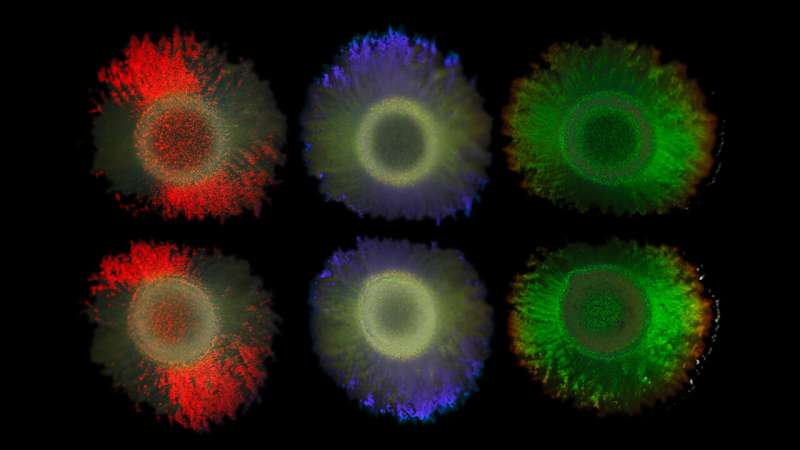This article has been reviewed according to Science X's editorial process and policies. Editors have highlighted the following attributes while ensuring the content's credibility:
fact-checked
peer-reviewed publication
trusted source
proofread
Bacterial glitter: New findings open up possibilities for sustainable color technologies

An international team of researchers of the Cluster of Excellence "Balance of the Microverse" at the University of Jena has investigated the mechanism that makes some types of bacteria reflect light without using pigments. The researchers were interested in the genes responsible and discovered important ecological connections. Their findings appear in the Proceedings of the National Academy of Sciences.
The iridescent colors known from peacock feathers or butterfly wings are created by tiny structures that reflect light in a special way. Some bacterial colonies form similar glittering structures.
In collaboration with the Max Planck Institute of Colloids and Interfaces, Leibniz Institute DSMZ-German Collection of Microorganisms and Cell Cultures, Utrecht University, University of Cambridge, and the Netherlands Institute for Sea Research, the scientists sequenced the DNA of 87 structurally colored bacteria and 30 colorless strains and identified genes that are responsible for these fascinating colonies. These findings could lead to the development of environmentally-friendly dyes and materials, a key interest of the collaborating biotechnology company Hoekmine BV.
Predictions with artificial intelligence
The researchers trained an artificial intelligence model to predict which bacteria produce iridescent colors based on their DNA.
"With this model, we analyzed over 250,000 bacterial genomes and 14,000 environmental samples from international open science repositories," says Prof. Bas E. Dutilh, Professor of Viral Ecology at the University of Jena and researcher in the Cluster of Excellence "Balance of the Microverse."
"We discovered that the genes responsible for structural color are mainly found in oceans, freshwater, and special habitats such as intertidal zones and deep-sea areas. In contrast, microbes in host-associated habitats such as the human microbiome displayed very limited structural color," Prof. Dutilh continues.
The study results indicate that the colorful bacterial colony structures are not only used to reflect light. Surprisingly, these genes are also found in bacteria that live in deep oceans without sunlight. This could imply that the colors could reflect deeper processes of cell organization with important functions, such as protecting the bacteria from viruses, or efficiently colonizing floating food particles. These findings could inspire new, sustainable technologies based on these natural structures.
More information: Colin J. Ingham et al, Structural color in the bacterial domain: The ecogenomics of a 2-dimensional optical phenotype, Proceedings of the National Academy of Sciences (2024). DOI: 10.1073/pnas.2309757121
Journal information: Proceedings of the National Academy of Sciences
Provided by Friedrich Schiller University of Jena




















